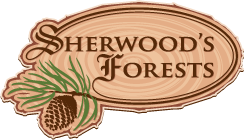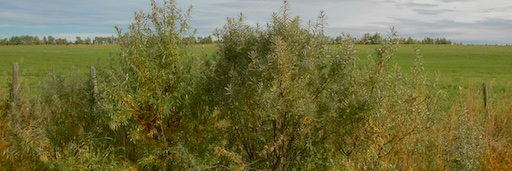
Buckthorn Hedge
Oleasters
Sea Buckthorn, Buffaloberries, Wolf Willow, Russian Olive,
Tough plants for harsh conditions
These are not quite desert plants. Plants for short grass prairie conditions: Marginal water, alkali or somewhat salty soil, poor conditions. This group of plants tends to have silvery foliage, narrow leaves. As a group, they tend to sucker and form thickets.
All but one have grey leaves to reduce heat stress. (The exception, Canada Buffaloberry, is also the one that grows wild in the Edmonton Area.)
All are thorny. All will grow on poor soil. They fix their own nitrogen, like peas and clover.
All are di
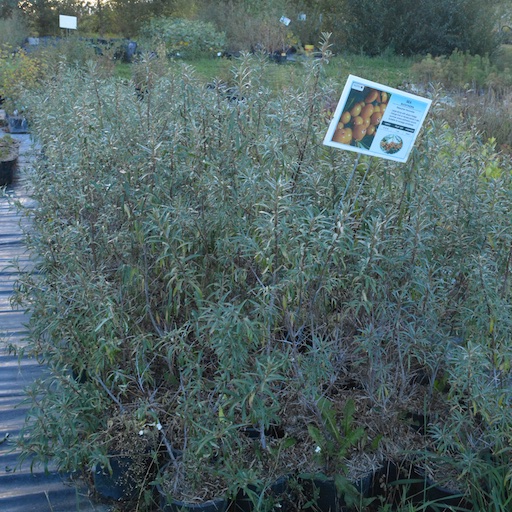
Two gallon Sea Buckthorn ready to go to their new home.
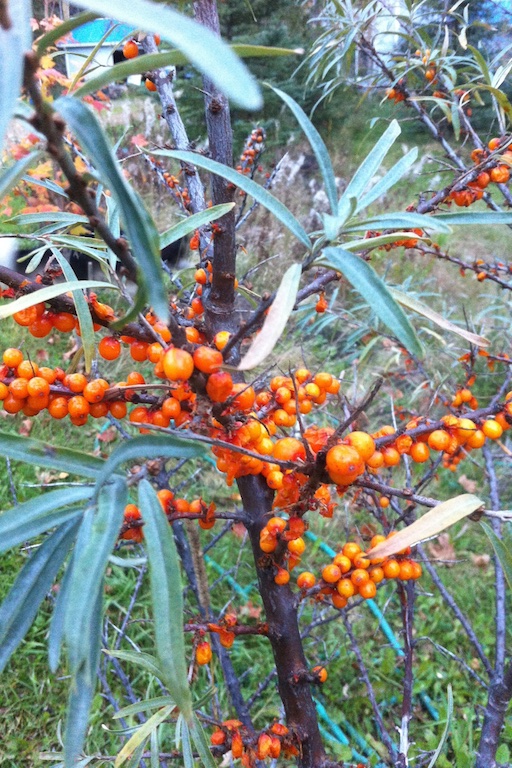
This is what the buckthorn berries look like. And look at those thorns. Heavy jacket, leather gloves required.
Sea Buckthorn
A grey green shrub with monster thorns. This is the ultimate barrier hedge if you share a boundary with an unlikable neighbour. It's also a good wildlife shrub. The berries provide food, and the thorns discourage any predator larger than a weasel.
The berries are full of antioxidants, but from experience, my hands were bleeding after half an hour. I suggest wearing biker leathers to work with this plant.
The shrub has interesting possibilities for decoration, especially if receiving visits from small grabby children. Spray painted black they would be good halloween decorations.
Buckthorn suckers. Given it's antisocial nature, it's best planted where you can mow close.

Take a close look. Most twigs end in a very sharp point. In addition to the 2-4 inch long thorns.
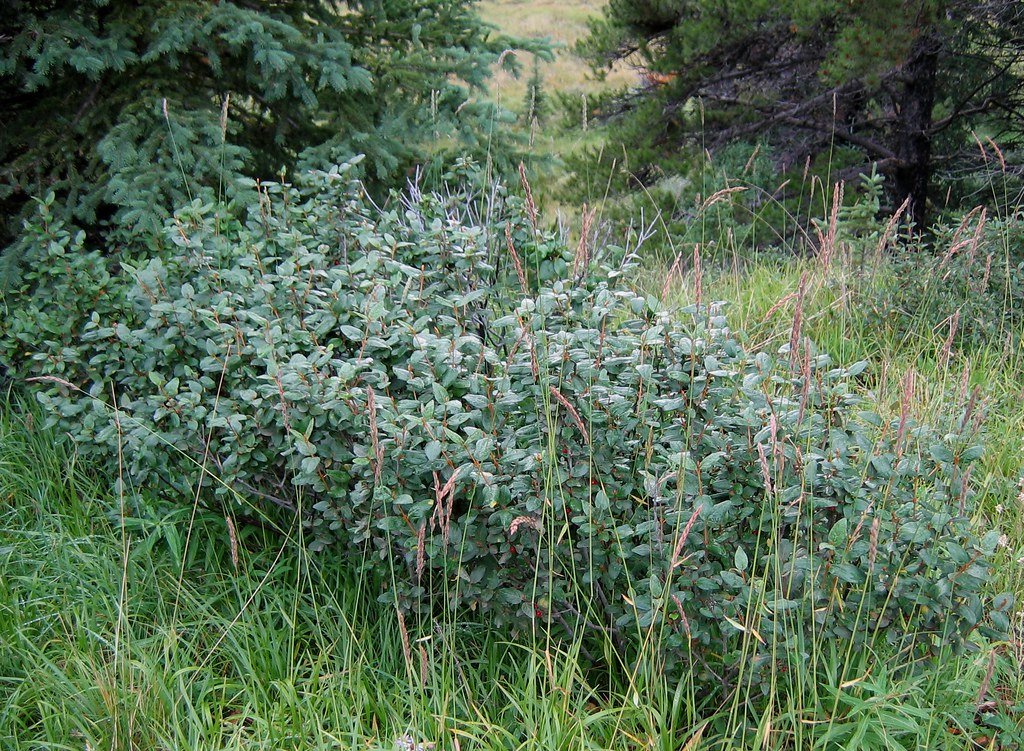
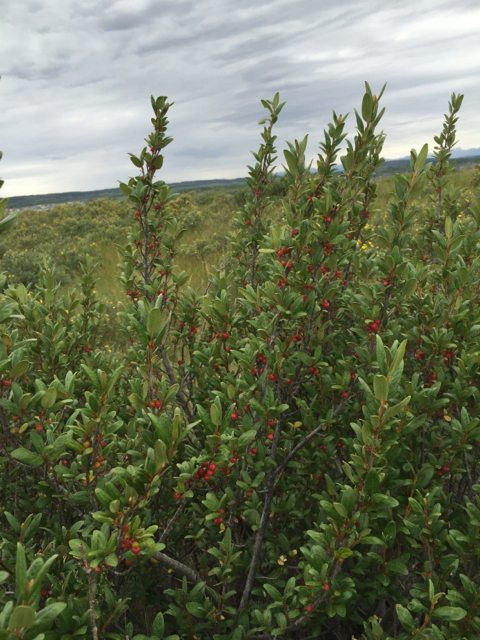
Canada buffaloberry in the wild.
Canada Buffaloberry
Shepherdia canadensis
This is a native plant, moderately common in clearings and roadsides in the Aspen Parkland ecozone. I've seen on road sides, above the ditch bottoms, in bright sunny areas, usually on well drained soil.
Shrub, 4-10 feet tall, with Dark green leaves above, rusty brown underneath. Red berries in the fall. Berries are edible, but taste soapy. (One of the common names for it is 'soap berry')
Good for first row of shelterbelts, wildlife habitat enhancement. Low maintenance shrub.
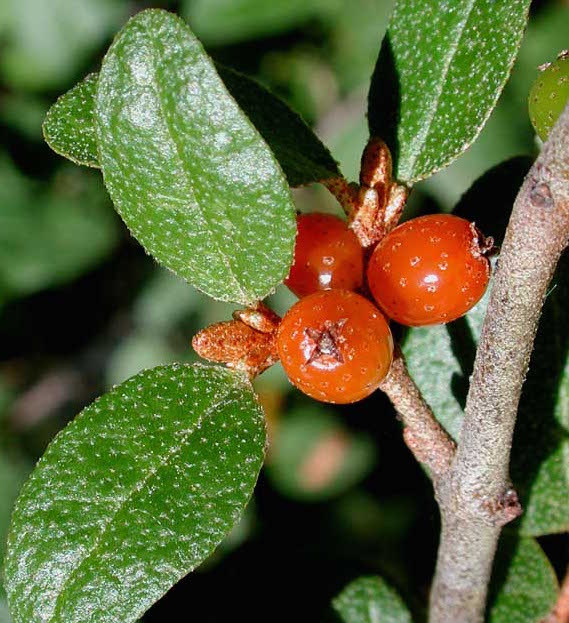
Canada buffaloberry is the only one with green instead of grey leaves. Here you see the red berries that rippen in mid to late summer.

Silver Buffaloberry. Fruit and leaves.

Silver Buffaloberry used as a landscape plant.
Silver Buffaloberry
Shepherdia argentia
Similar berries to the Canada Buffaloberry., more orange than red. Silver grey foliage. Short grass prairie/Mixed grasslands native.
Tends to be a bit rattier looking than it's northern cousin. Prune back to knee height now and then if using it for landscaping.
Both types of buffaloberry at Colorado State University
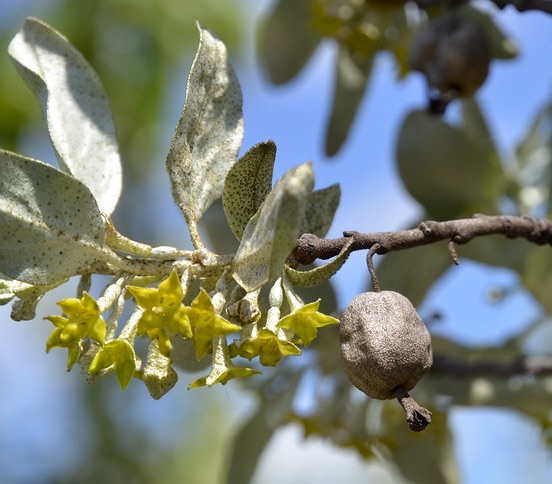
Wolfwillow branch showing twisted leaves, flowers, and a single berry from last year.

Wolfwillow will spread by suckers. Not a problem if you can mow.
Wolf Willow
Elaeagnus commutata
Wolf willow is not a willow, but a member of the same genus as Russian olive. The leaves are grey-green, with very pale undersides, but unlike other members of this group are only about twice as long as they are wide. The leaves are not flat, but are curled and twisted. It tends to form thickets, 4 to 8 feet tall.
Wolf willow has small yellow flowers in spring, with a heavy, almost cloying scent. Some people love it, some hate it. Meet one and check before planting close to the house.
This is a native shrub in both the Aspen Parkland and mixed grassland ecozones, frequently found on dry rocky or sandy sites near rivers, and road cuts. Does not establish easily on grassy areas, but seems to need disturbed land to get started.
While most often found in open sun, it tolerates shade. I first met wolf willow on a the Devil's Elbow portage upstream of Nordegg. They were scattered along the portage trail. The pale leaves looked almost luminous against the shade of mixed spruce and poplar.
In the spring Wolf willow has a small yellow flower with a very strong heavy scent. Later it has berries that are the same colour as the leaves, hence it's other name, Silverberry, causing some confusion with silver buffaloberry. Each berry has a single nut inside, brown with yellow stripes. Natives and early settlers used these decoratively. They can be eaten, but only if the option is starvation.

Big Russian Olive Tree. I've not seen one this big locally. This one's pushing 40 feet. 2/3 of this is much more common.

Russian Olive tree more typical size. This one is in bloom.
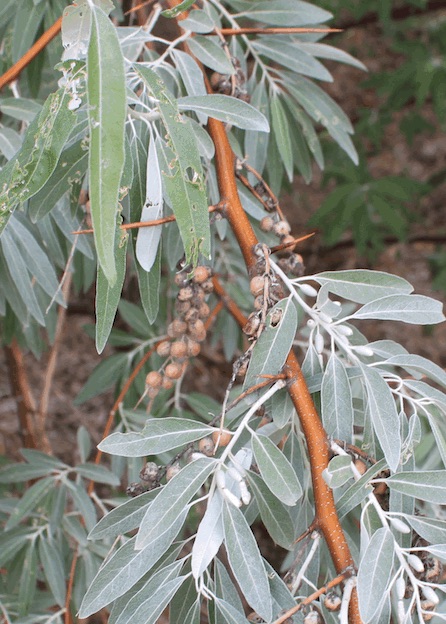
Russian Olive Branch. Leaves are long, narrow, and flat. Compare to wolfwillow leaves which are shorter, wider, and always a bit twisted.
Russian Olive
Elaeagnus angustifolia
Wolf willow's big brother. Long narrow silverly leaves, tiny yellow flowers.
Some reports of winterkill in northern Alberta. Dark brown furrowed bark.
This tree is NOT recommended for southern Alberta, as it has become invasive, particularly in creeks and rivers, where the seeds spread fast and far down stream on spring high water. I think it requires disturbed soil to start. My local horticulture groups don't mention it as being a weed tree, unlike their elm and maple.
As a low care ornamental in the city or on an acreage property, it's fine.
Wikipedia's article on Russian Olive
Colorado Plant database on Russian Olive
Inventory tables are double rows to make them usable on small screens.
Common name and container in column 1.
Count is how many we think we have left. Price is per tree.
Height will be there next year, we hope.
Leaf -- Silverleaf
| Common Name Container |
Count Price |
Height (feet) |
|
| Buckthorn, Sea, seed run #2 Std pot (6 qt) |
40 $27.50 |
||
| Buffaloberry, Canada 1000 ml Styroblock |
360 $8.00 |
||
| Buffaloberry, Canada 125 ml plug - 10/bundle |
180 $4.00 |
||
| Buffaloberry, Silver #1 Std pot (3 qt) |
38 $10.00 |
||
| Buffaloberry, Silver #2 Std pot (6 qt) |
180 $22.50 |
||
| Buffaloberry, Silver #2 Std pot (6 qt) |
75 $27.50 |
||
| Buffaloberry, Silver 1-2 yr Bare Root Seedling 25/bundle |
125 $3.50 |
||
| Buffaloberry, Silver 125 ml plug - 10/bundle |
160 $4.00 |
||
| Russian Olive, common #1 Std pot (3 qt) |
-25 $3.50 |
||
| Russian Olive, common #2 Std pot (6 qt) |
26 $30.00 |
||
| Russian Olive, common 1-2 yr Bare Root Seedling 25/bundle |
100 $3.50 |
||
| Wolf Willow, Silverberry #2 Std pot (6 qt) |
120 $27.50 |
||
| Last Update: 2024-Jan-21 | |||
Got something to say? Email me: sfinfo@sherwoods-forests.com
Interesting? Share this page.
Want to talk right now? Call me: (8 am to 8 pm only, please) 1-780-848-2548
Do not arrive unannounced. Phone for an appointment. Why? See Contact & Hours That same page gives our hours of operation.
Back to Top
Copyright © 2008 - 2021 S. G. Botsford
Sherwood's Forests is located about 75 km southwest of Edmonton, Alberta. Please refer to the map on our Contact page for directions.
